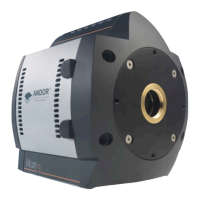Page 72
Appendix
A1.1.12 - Noise
Noise is a complex topic, the full exploration of which is beyond the scope of this glossary. However noise may be
broken down into two broad categories, as follows:
1. Pixel Noise
2. Fixed Pattern Noise
A1.1.12.1 - Pixel Noise
Let us rst attempt to dene pixel noise. Assume that a light signal is falling on a pixel of the CCD. If the charge on the
pixel is read, and the read process is repeated many times, the noise may be taken as the variation in the values read.
The Root Mean Square (rms) of these variations is often used to express a value for noise. As a rule of thumb, the rms
is 4x to 6x smaller than the peak to peak variations in the count values read from the pixel. Pixel noise has three main
constituents:
• Readoutnoise
• Shotnoisefromthedarksignal
• Shotnoisefromthelightsignalitself
Shot noise cannot be removed because it is due to basic physical laws. Most simply dened, shot noise is the square
root of the signal (or dark signal) measured in electrons
A1.1.12.1.1 - Readout Noise
Readout noise (which in our detectors is, in any case, low) is due to the amplier and electronics. It is independent of
dark signal and signal levels and is only very slightly dependent on temperature. It is present on every read, as a result
of which it sets a limit on the best achievable noise performance. Shot noise from the dark signal is dependent on the
exposure time and is very dependent on the temperature; shot noise from the signal is additionally dependent on the
signal level itself. If either the signal or the dark signal falls to zero, their respective shot noise also falls to zero. The total
pixel noise is not, however, simply the sum of the three main noise components (readout noise, shot noise from the dark
signal, and shot noise from the signal). Rather, the rms gives a reasonable approximation - thus:
total = sqrt (readnoise² + darkshot² + sigshot²)
where:
• total is the pixel noise
• readnoise is the readout noise
• darkshot is the shot noise of the dark signal
• sigshot is the shot noise of the signal
A1.1.12.2 - Fixed Pattern Noise
Fixed Pattern Noise (FPN) consists of the differences in count values read out from individual pixels, even if no light is
falling on the detector. These differences remain constant from read to read. The differences are due in part to a variation
in the dark signal produced by each pixel, and in part to small irregularities that arise during the fabrication of the CCD.
Since xed pattern noise is partly due to dark signal, it will change if the temperature changes, but because it is xed, it
can be completely removed from a measurement by background subtraction.

